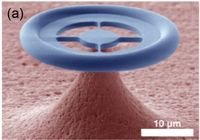Quantum Dots & Microcavities
Exploring the micro, nano and quantum world
- Observing quantum effects in relatively large structures
- Widely tunable mode-hop-free lasers for studying resonance frequencies
- Application as single photon sources, qubits for quantum computers, telecommunication devices, frequency combs or in nonlinear optics
Quantum dots as well as microcavities have become increasingly important for numerous applications, for example single photon sources, qubits for quantum computers, telecommunication devices, frequency combs or nonlinear optics. Many of these applications approach quantum limits and depend on light sources that fulfill demanding requirements in terms of linewidth, noise, high resolution tuning, flexibility and control. Usually, narrow-bandwidth lasers that are tunable without mode-hopping are utilized to detect, study and use resonance frequencies of quantum dots and microcavities.
Microcavities
Quantum properties are usually not observable in macroscopic objects due to environmental decoherence unless specific sample geometries and cooling are utilized. Employing microcavities, for example, is one possibility to observe quantum effects in a relatively large, micrometer-scaled structure. The image illustrates an isolated, donut-shaped glass microcavity of about 30 microns in diameter. With this geometry, it is a macroscopic mechanical oscillator and a ring-shaped high Q optical cavity at the same time: light of certain wavelengths can be coupled into it via evanescent wave coupling. The oscillating light bounces off the walls of the donut by total internal reflection and thus transfers a small force on the structure by radiation pressure.
In this way, the coupled light can influence the vibrational behavior of the structure and vice versa. This turns microcavities into interesting objects for quantum research. For example, in [1] such parametric coupling between light and mechanical oscillations was observed. In [2] a sensor that is based on optomechanical coupling was used for active feedback cooling of such a microcavity.
Because of their small size, the free spectral range of microcavities is relatively large, and tiny size deviations cause large spectral shifts. Hence, a widely mode-hop-free tunable laser is an invaluable tool to find and study the resonance frequencies of microcavities.
The spectral dependence on size and other environmental parameters of microcavities can be exploited for a promising application: label-free detection of single biological molecules in solution. This is enabled using a microtoroid optical resonator in combination with a widely tunable mode-hop-free laser like CTL. In [3] it is described how such a laser is stabilized to a microtoriod optical resonator and how shifts of the optical resonance frequency caused by molecules binding to the resonator are observed. The laser follows the frequency change and by examining the shift in laser frequency, particles of radius between 2 nm and 100 nm can be detected and distinguished.
Quantum Dots
Semiconductor quantum dots are exciting nanostructures that show atom-like behavior because of their small size and three-dimensional confinement. Due to the confinement, electronic states in quantum dots are quantized and such structures are often referred to as artificial atoms. Atom-like properties have been verified by demonstrating strong photon antibunching and near lifetime-limited linewidths. Quantum dots in general are interesting systems to realize qubits, and especially semiconductor quantum dots are promising candidates for scalable quantum computers since semiconductor processing is well studied and understood: Unlike real atoms, semiconductor quantum dots can be grown and placed in a controlled fashion. By integrating quantum dots into other semiconductor structures like waveguides or photonic crystal structure (e.g. cavities), even cavity QED experiments are possible without the need for trapping atoms.
En route to scalable qubit arrays, coupled quantum dots have recently raised a lot of interest. Electron transport measurements on coupled quantum dots have demonstrated spin-sensitive coupling and manipulation of electron and nuclear spins, and optical spectra of coupled excitons have been measured and calculated in self-assembled coupled quantum dots.
Resonant optical excitation of quantum dot states is crucial in particular for coherent state manipulation and detection. However, due to the intrinsically random growth process, all quantum dots are slightly different in size and hence feature different optical resonance frequencies. To find and resonantly excite the optical transitions of a single quantum dot, a widely mode-hop-free tunable, narrow band laser is an ideal tool.
-
Related Products
-
Related Applications
-
Related Literature
- [1] E. Verhagen, et al., Quantum-coherent coupling of a mechanical oscillator to an optical cavity mode, Nature 482 (2012).
- [2] D. J. Wilson, et al., Measurement and control of a mechanical oscillator at its thermal decoherence rate, Nature 524 (2015)
- [3] Su, Tsu-Te Judith, et al., Label-free detection of single biological molecules using microtoroid optical resonators, Light: Science & Applications (2016)
- R. Neuhaus, et al., Exploring the Micro, Nano and Quantum World, Optik & Photonik, Vol. 10, Issue 2 (2015)

